Translate this page into:
Comparison of conservative and operative management for unstable extra articular proximal phalanx fracture of hand: A prospective study
Address for correspondence: Dr. Ramesh Chandra Maharaj, Department of Orthopaedics, S.C.B. Medical College and Hospital, Cuttack, Odisha, India. E-mail: rameshchandramaharaj@gmail.com
-
Received: ,
Accepted: ,
This article was originally published by Wolters Kluwer - Medknow and was migrated to Scientific Scholar after the change of Publisher.
How to cite this article: Khatua J, Nanda DP, Panigrahi R, Maharaj RC. Comparison of conservative and operative management for unstable extra articular proximal phalanx fracture of hand: A prospective study. J Orthop Spine 2020;8:103-12.
Abstract
BACKGROUND:
Hand injuries are often overlooked and are not given the importance that they deserve. Decision-making in the management of phalangeal fractures is crucial rather more difficult than long bone fractures; as no treatment will lead to deformity and over treatment will cause stiffness.
AIM OF THE STUDY:
Compare the results of both conservative and operative managements of proximal phalangeal fractures for decision making while dealing with these innocent looking injuries.
SUBJECTS AND METHODS:
This was a prospective study of 60 patients of unstable extra articular proximal phalangeal fractures over 2 years. Fifty percent of the patients managed conservatively and 50% surgically. Results were analyzed by the assessment of total range of movements (TROM); functional score of Belesky et al.; grip strength; time of return to work and complications associated with each methods.
RESULTS:
There was no statistically significant difference between conservative and operative group (TROM P 0.063; Belesky score P = 0.135). Among all modalities best results was achieved with Close Reduction and Internal Fixation (CRIF) with percutaneous k wires which was statistically and clinically significant as compared to conservative and Open Reduction and Internal Fixation (ORIF) group (TROM P = 0.012; Belesky score P = 0.024]. Complications were mostly malunion with conservative methods and infection; implant failure; CRPS were more common in operative methods.
CONCLUSION:
Conservative management is preferred over surgery for unstable proximal phalangeal fractures. If surgery is needed for stability than close reduction (CRIF) with percutaneous k wire is preferred over open techniques (ORIF).
Keywords
Bone wires
conservative treatment
decision-making
finger phalanges
fractures
open fracture reduction
Introduction
Last century orthopedics have witnessed significant progression from traction and splints to robotic surgery. However, hand injury and its managements are still underestimated either they are missed or overlooked or does not get importance like long bone fracture. Swanson aptly said, “ Hand fractures can be complicated by deformity from no treatment, stiffness from over treatment and both deformity and stiffness from poor treatment.”[1] In the modern world, the human hand is the most vulnerable part of the body prone for variety of injuries such as industrial, sports, agriculture, and accidents. Phalanges and metacarpals are the most common type of fracture of the upper extremity and accounts for 10% of total such cases.[2] Until the earlier part of the 20th century, these fractures were treated conservatively. Now, the management of proximal fracture is based on the type of the fracture; displacement and difficulty in maintaining the reduction. The management ranges from elevation, rest, splinting, cast to open or close reduction and internal fixation by k-wires, plate, screws, wiring, external fixation, etc., but no optimum modality of treatment is chosen till today. Fracture those are undisplaced or minimally displaced are treated conservatively. Displaced fractures require operative intervention.
Kirschner wire (k-wires) fixation of the phalangeal fracture is technically easy, universally available; can be used single or multiple or crossed. However, it is not a rigid fixation with complication rate up to 18%.[3,4,5] Intraosseous wiring can be used alone or as a supplement to k-wire. It requires minimal exposure, get compression across the fracture site and rigid fixation then k-wire with theoretically minimal risk of adhesion.[6,7] Mini-plate is another evolving technique but results are not encouraging with poor outcome up to 41%, as there is considerable soft-tissue injury.[5] Main complication of conservative management is malunion and deformity. Complications of surgical management is stiffness due to soft-tissue injury though alignment is achieved.[8,9]
Hence, choosing the ideal modality of management for proximal phalangeal fracture is a tough job. Therefore, the aim of this study is to compare the results and complications of conservative and operative management of proximal phalanx fracture that will help us in decision-making while dealing with such injuries.
Subjects and Methods
This was a prospective study conducted from October 2017 to November 2019 after obtaining institutional ethical committee approval. It included 60 patients with unstable extra articular proximal phalangeal fracture, of which 30 patients were managed conservatively and 30 patients surgically. Intra articular fractures, undisplaced fractures and fractures associated with neurovascular injuries were excluded from the study. Patients were hospitalized, routine blood investigation and radiological examination anteroposterior (AP), lateral and oblique views of the affected digits were done. Management protocol followed as per Freeland et al.[10] [Figure 1].
![Algorithm for hand fracture. CR: Close reduction, EF: External fixation, IF: Internal fixation, LOR: Limited open reduction, OR: Open reduction[9]](/content/178/2020/8/2/img/JOAS-8-103-g001.png)
- Algorithm for hand fracture. CR: Close reduction, EF: External fixation, IF: Internal fixation, LOR: Limited open reduction, OR: Open reduction[9]
All patients with displaced proximal phalangeal shaft fracture posted for close manipulation under digital block or regional anesthesia and image intensifier. In those stable reduction was achieved after close manipulation, were planned for conservative management and all other cases planned for surgery as per the fracture pattern and stability.
Conservative management
In those stable reduction was achieved or who did not give consent for surgery were included for conservative management. Injured finger was buddy taped with adjacent finger after reduction and hand was immobilized in James position for 3 weeks. At 3 weeks, splint was discontinued and patients under went supervised rehabilitation protocol with splint to be worn at rest for the next 3 weeks. At 6 weeks, both splint and buddy tap were discontinued and active finger movements were encouraged [Figure 2].

- Preoperative oblique and AP radiograph of proximal phalanx base fracture of left hand little finger (a and b). Buddy strapping little and ring finger (c and d). Postoperative 6th month radiograph (e and f). Hand functions at 6th month (g-i)
Close reduction (CRIF) and k-wire fixation
Fracture those were not stable with close manipulation alone were planned for close reduction with k-wire fixation. Crossed k wires were preferred over single intra medullary k-wire [Figure 3].
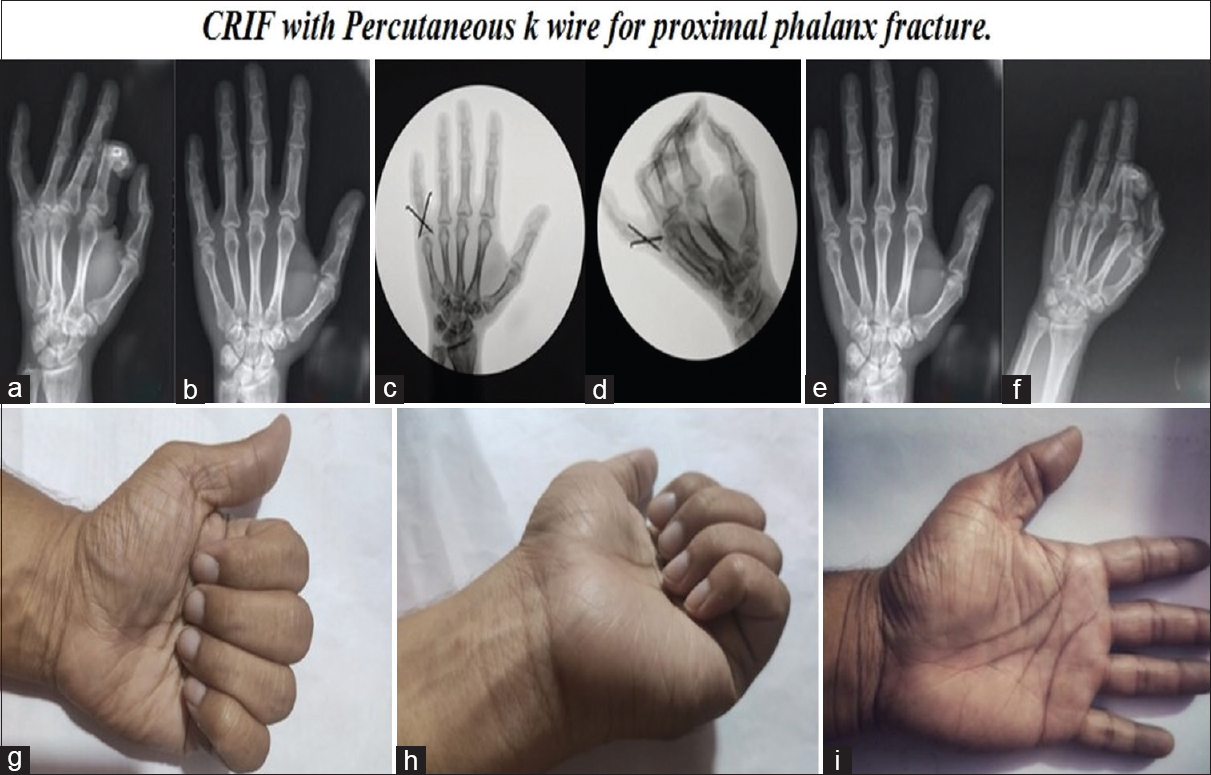
- Preoperative oblique and AP radiograph of the right hand little finger proximal phalanx base fracture (a and b). Intraoperative C-arm images (c and d). Radiograph after 6th month (e and f). Hand functions at 6th month (g-i)
Open reduction (ORIF)
If close reduction failed, open reduction was done through dorsal incision, with extensor tendon splitting approach. The fracture site was opened reduced and fixed with antegrade or retrograde cross k-wires, intraosseous wiring, or miniplate fixation.
Intraosseous wiring
Described by Lister in 1978.[6,7] In this study, a modified Lister's technique was used, where the fracture were opened, reduced, and compressed with transversely passed 22/24 G stainless still wires parallel to the fracture. It was supplemented with an obliquely passed 1.25 mm k-wire for rotational stability. It is cheap, easily available, and more rigid fixation than k-wire alone. It is mainly useful for transverse fracture and likely to injure extensor tendon [Figure 4].

- Preoperative AP and oblique radiograph of proximal phalanx shaft fracture right hand middle finger (a and b). Intraoperative clinical and C-arm image (c and d). Postoperative 6th month radiograph (e and f). Hand functions at 6th month (g-j)
Miniplate osteosynthesis
Miniplate was used in cases where close reduction failed and intraosseous wiring was not an ideal implant. Fracture approached dorsally and extensor tendon apparatus was split through lateral band. It was fixed with 1.5/2 mm miniplate on the lateral aspect of the proximal phalanx with minimum two screws on either side of the fracture. This was the most rigid method of fixation but extensive soft-tissue dissection was needed [Figure 5].

- Preoperative AP and oblique radiograph of proximal phalanx shaft fracture middle finger (a and b). Intraoperative clinical and C-arm image (c-e). Postoperative 6th month AP and oblique radiograph (f and g). Hand functions at 6th month (h-j)
All patients were followed up at 3 weeks, 6 weeks, 3 months, and 6 months. K-wire exit and splint was discontinued at 3 weeks and patients subjected to supervised rehabilitation protocol. All patients were assessed for functional results at 6 months, by measuring total range of movements (TROMs); grip strength as compared with normal hand as control and functional score by Belesky et al.'s score[11] [Table 1].
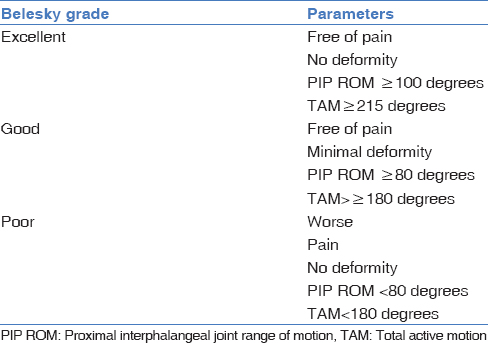
Statistical analysis was performed by Microsoft excel computer software. Data were presented as number, percent, mean and standard deviation. We analyzed functional results of two groups using Chi-square test of association. P < 0.05 was considered statistically significant. To examine strengths of associations, we computed odds ratios (OR) with 95% confidence intervals (CI).
Results
A total of 66 patients, of which 6 patients were lost to follow-up. Males are more commonly affected 44 (73%). Common age group involved were 21–30 years 20 (33%), 31–40 years 19 (32%). The most common cause of injury was road traffic accidents 30 (50%). The right hand was more commonly affected 33 (55%). Little finger was injured in 18 (30%) and ring finger in 17 (28%) patients. Shaft fractures were most common 34 (57%). Transverse pattern were more common 20 (33%) and 39 (65%) cases were unstable [Table 2].
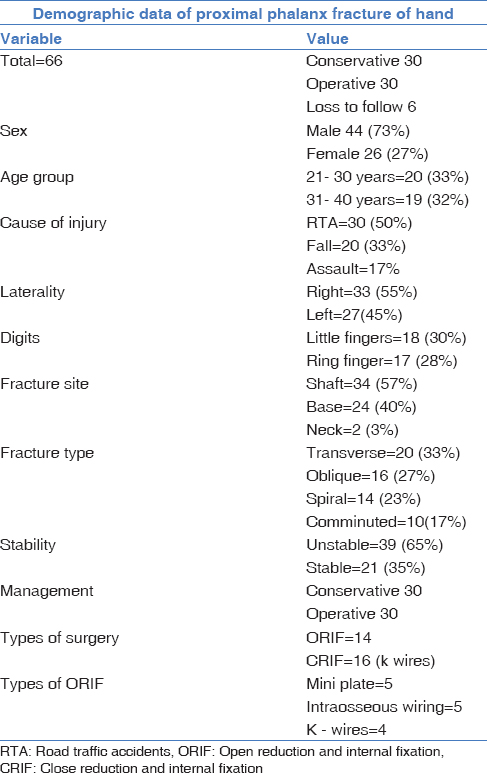
Analysis of the outcomes of interventions on proximal phalangeal fracture were based on the measurement of TROM, functional score of Belesky et al., grip strength and time of return to works in weeks.
TROM achieved by different methods [Table 3].

Excellent or good results was seen in 15 (50%) in conservative group and 22 (73%) in operative group. However, it was not statistically significant, P = 0.063. This was due to the masking of the better result of CRIF with k-wires by worse results of ORIF [Table 4].

When conservative group compared with (CRIF) with percutaneous K-wires alone, showed both clinically and statistically significant difference between them; P = 0.012 [Table 5].
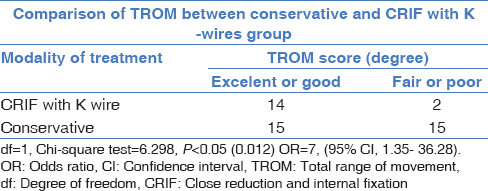
When compared percutaneous k wire (CRIF) with open method (ORIF), there was no statistically significant difference, P = 0.061 but clinically significant. This may be due to the small sample size of both groups (n1 = 16; n2 = 14) [Table 6].
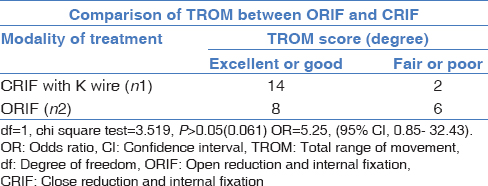
Functional assessment as per Belesky et al. criteria for different methods of managements at 6 month of fracture healing [Table 7].
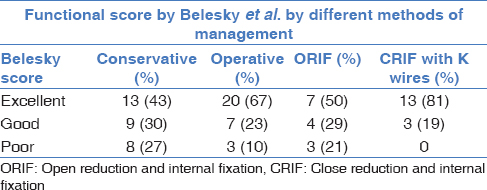
There was no statistical significant difference between conservative and operative group, P = 0.135 though significant clinical difference existed. This was due to the masking of the better result of (CRIF) group by worse results of open method (ORIF) [Table 8].
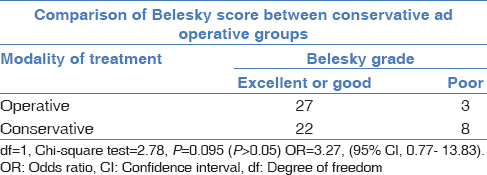
When we compared conservative group with percutaneous k-wire (CRIF) group; there were both clinical and statistically significant difference P = 0.024 [Table 9].
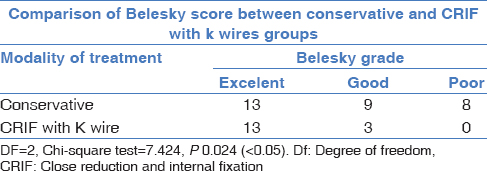
When (ORIF) compared with CRIF group, it showed no statistical difference P = 0.089. However, there was clinically significant difference [Table 10].

Grip strength was achieved up to ≥90% of normal strength in 12 (40%) conservative group; 18 (60%) in operative group (12 CRIF and 6 ORIF) [Table 11].

Average grip strength was 83.5 ± 9% in conservative group and 86.17 ± 8.6% in operative group showing no significant difference between two groups.
Time of return to work in weeks after different methods of the management of proximal phalanx fracture [Table 12].
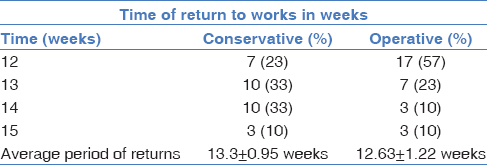
There was no significant difference in average time of return to work between conservative (13.3 ± 0.95 weeks) and operative groups (12.63 ± 1.22 weeks).
Complications encountered during the management and follow-up periods by different methods for proximal phalanx fracture were discussed as follows [Table 13 and Figure 6].

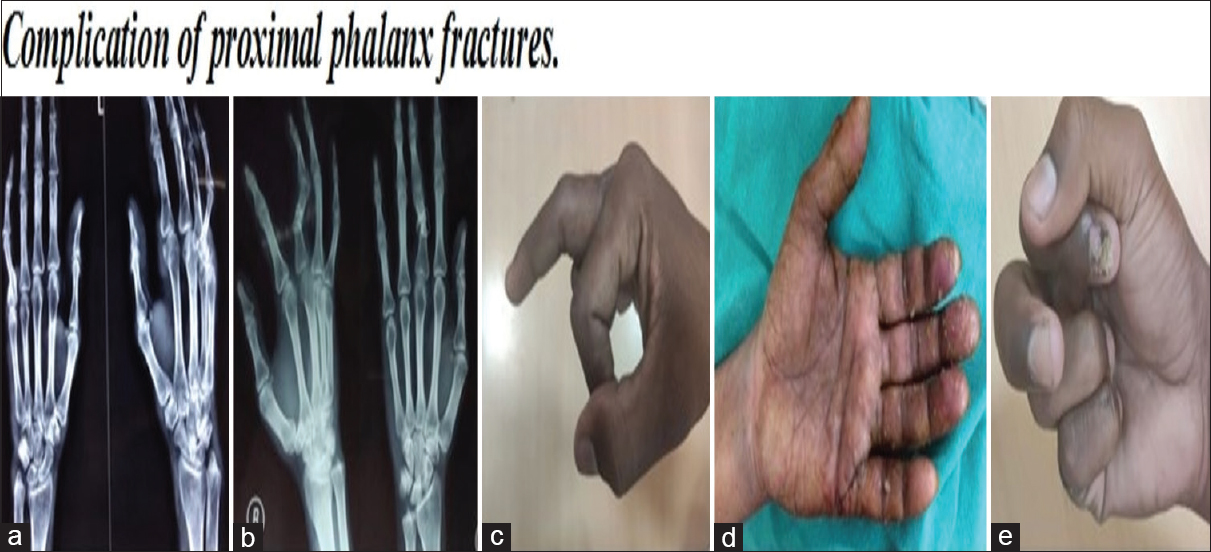
- Complication of proximal phalanx fracture. (a) Malunion of conservative management. (b) Implant failure of interosseous wiring. (c) Flexion lag of percutaneous k wire. (d) CRPS of percutaneous K wire. (e) Crowding of intraosseous wiring
Summarizing the results [Table 14], it showed no statistical difference though clinical difference exist between conservative and operative management for TROM and Belesky scores. There was no significant difference between them for average grip strength and time of return to work. Complications are more common with operative group than conservative group. Among all modalities, percutaneous k wire (CRIF) stands out as the best modality but the sample size is smaller (n = 16) as compared with conservative management (n = 30).

Discussion
We compared the results of this study with the selected studies published in literature on outcomes of the proximal phalangeal fractures management, few of them are discussed below in detail [Table 15]. Pun et al. “A prospective study on 284 digital fracture of hand.”[5] One hundred and nine unstable fracture treated with k wires, 70% had fair or poor results. Open fractures, comminuted fractures, and associated significant soft-tissue injuries were unfavorable prognostic signs.
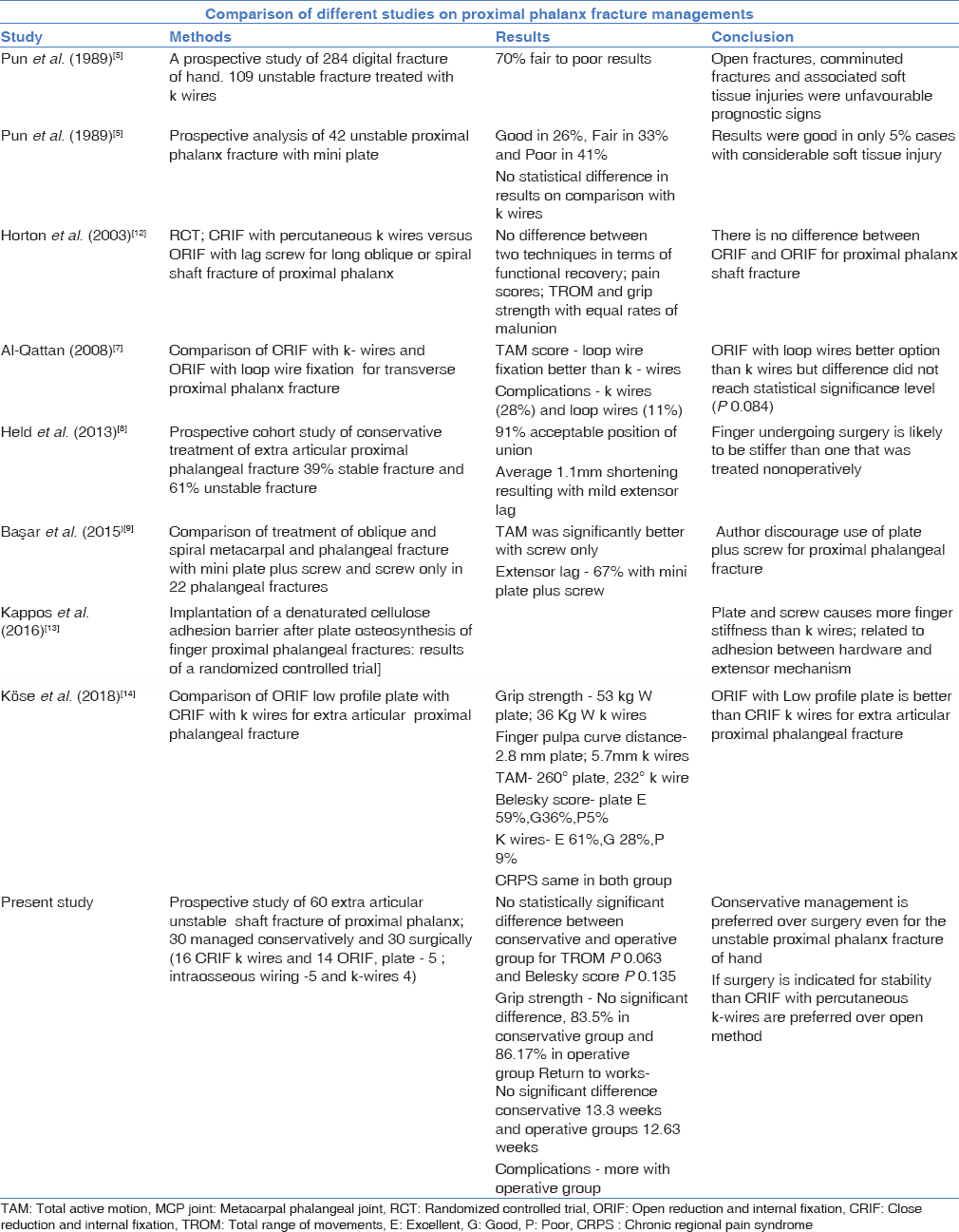
They also analyzed prospectively 42 unstable proximal phalanx fixed with AO mini plate. Results were good in 26%; fair in 33% and poor in 41% and good results were seen in only 5% when there was considerable soft tissue injury. When plate compared with k wires, there was no statistically significant difference between them.
Held et al. “Conservative treatment of fractures of the proximal phalanx: An option even for unstable fracture patterns.”[8] A prospective cohort study; treated both stable (39%) and unstable (61%) extra articular proximal phalanx fracture non operatively. 91% maintained an acceptance position with an average shortening of 1.1 mm that resulted in mild extensor lag. They concluded that, a finger undergoing any type of surgery is likely to be stiffer than one that was treated non operatively.
Al-Qattan et al. reported the study of transverse fracture of the shaft of proximal phalanx fracture which were treated with percutaneous k-wire fixation and open reductions and loop wire fixation.[7] In the follow-up, second group had better TAM score than first group. The complication rate was higher in the first group than the second group (28% versus 11%). However, difference did not reach statistical significance (P = 0.084).
Horton et al. “A prospective randomized controlled study of fixation of long oblique and spiral shaft fractures of the proximal phalanx: Closed reduction and percutaneous Kirschner wiring versus open reduction and lag screw fixation.”[12] Fifteen patients treated with CRIF with k wires and 13 with close reduction and lag screw fixation. Outcome was assessed in terms of pain, movement, grip strength and function. There was no difference in the functional recovery; pain scores; total range movements and grip strength with equal rates of malunion.
Ahmet Kose et al.; published retrospective analysis on comparison of low profile plate screw and k-wires fixation for extrarticular proximal phalanx fracture.[14] He included 22 patients in ORIF with plate and 18 patients in CRIF with k wires. He got better results in plate group then k wires in terms of grip strength, fingers pulpa-curve distance, TAM, and Belesky scores.
Basar et al. comparison of treatment of oblique and spiral metacarpal and phalangeal fractures with mini plate plus screw or screw only.[9] They included 22 phalangeal fracture that were approached with dorsal extensor tendon splitting incision. TAM was significantly better with screw only, prompting author to discourage use of plate plus screw. An extensor lag found in 67% with plate that needed plate to be removed. They concluded mini plate used dorsally had frequent adhesions and poor postoperative finger motion.
Two other studies relevant to this topic were as follows:
Rüedi et al. “AO Principles of Fracture Management.”[15] They concluded non operative treatment always create indirect healing whereas operative technique will encourage either direct or indirect healing based on the degree of stability. Indirect healing is associated with percutaneous k wires fixation and rigid fixation with lag screw or plate-screw leads to direct healing. Always indirect healing is preferred to direct healing as it preserves the biology of the fracture site encouraging natural healing.
Kappos et al. “Implantation of a denatured cellulose adhesion barrier after plate osteosynthesis of finger proximal phalangeal fractures: Results of a randomized controlled trial.”[13] Unlike K-wires which are removed at 3–4 weeks, screws and plates are intended to remain in place and may directly result in finger stiffness related to adhesions between the hardware and the extensor mechanism.
Observation made by this study was similar to many of them mainly Pun et al.; Horton et al.; Held et al.; Basar et al. and Kappos et al.; that pointed out that decision making in the management of phalangeal fracture is very important and crucial for the optimum results.
Author preferred conservative management over the operative techniques even if for the unstable variety of digital fracture and if at all surgery is mandatory for stability than close reduction (CRIF) with percutaneous k wires preferred over open techniques with special attention to extensor apparatus. In worst case if open reduction is needed, we still preferred k wires over the mini plate and if plate fixation is mandatory then we preferred extensor tendon sparing approach with lateral application of the plate for obtaining the best possible results.
Limitation of the study was the smaller sample size of the percutaneous CRIF group (n = 16) and ORIF group (n = 14) for which difference did not reach statistical significance level (P = 0.061 for TROM, P = 0.089 for Belesky score) though significant clinical difference existed between them.
Financial support and sponsorship
Nil.
Acknowledgment
I would like to thank Professor Dr Nirmal Chandra Mohapatra; MS, for his immense support for this piece of work.
Conflicts of interest
There are no conflicts of interest.
References
- Fractures involving the digits of the hand. Orthop Clin North Am. 1970;1:261-74.
- [CrossRef] [PubMed] [Google Scholar]
- Fractures of metacarpals and phalanges.Green's Operative Hand Surgery. Vol 1. (4th ed). Philadelphia, USA: Churchill Livingstone; 1999. p. :711-57.
- [Google Scholar]
- Closed reduction and percutaneous pin fixation of fractured phalanges. J Bone Joint Surg Am. 1973;55:1651-4.
- [CrossRef] [Google Scholar]
- Transmetacarpal intramedullary K-wire fixation of proximal phalangeal fractures. Ann Plast Surg. 1998;41:125-30.
- [CrossRef] [PubMed] [Google Scholar]
- A prospective study on 284 digital fractures of the hand. J Hand Surg Am. 1989;14:474-81.
- [CrossRef] [PubMed] [Google Scholar]
- Intraosseous wiring of the digital skeleton. J Hand Surg (Am). 1978;3:427-35.
- [CrossRef] [PubMed] [Google Scholar]
- Closed reduction and percutaneous K-wires versus open reduction and interosseous loop wires for displaced unstable transverse fractures of the shaft of the proximal phalanx of the fin.
- [Google Scholar]
- Conservative treatment of fractures of the proximal phalanx: An option even for unstable fracture patterns. Hand Surg. 2013;18:229-34.
- [CrossRef] [PubMed] [Google Scholar]
- Comparison of treatment of oblique and spiral metacarpal and phalangeal fractures with mini plate plus screw or screw only. Arch Orthop Trauma Surg. 2015;135:499-504.
- [CrossRef] [PubMed] [Google Scholar]
- Phalangeal fractures. In: Peimer CA, ed. Surgery of the Hand and Upper Extremity. New York: McGraw-Hill; 1996. p. :921-37.
- [Google Scholar]
- Closed reduction and internal fixation of proximal phalangeal fractures. J Hand Surg (Am). 1984;9:725-9.
- [CrossRef] [PubMed] [Google Scholar]
- A prospective randomized controlled study of fixation of long oblique and spiral shaft fractures of the proximal phalanx: Closed reduction and percutaneous Kirschner wiring versus open reduction and lag screw fixation. J Hand Surg Br. 2003;28:5-9.
- [CrossRef] [PubMed] [Google Scholar]
- Implantation of a denaturated cellulose adhesion barrier after plate osteosynthesis of finger proximal phalangeal fractures: Results of a randomized controlled trial. J Hand Surg Eur Vol. 2016;41:413-20.
- [CrossRef] [PubMed] [Google Scholar]
- Comparison of lowprofile platescrew and Kirschner wire osteosynthesis outcomes in extraarticular unstable proximal phalangeal fractures. Eur J Orthop Surg Traumatol. 2019;29:597-604.
- [Google Scholar]
- AO Principles of Fracture Management. New York, NY: Thieme; 2008.






